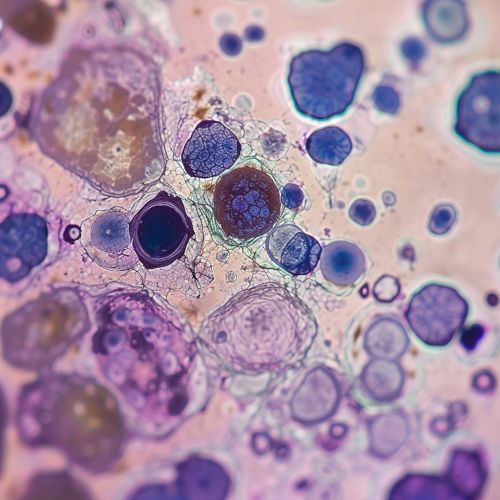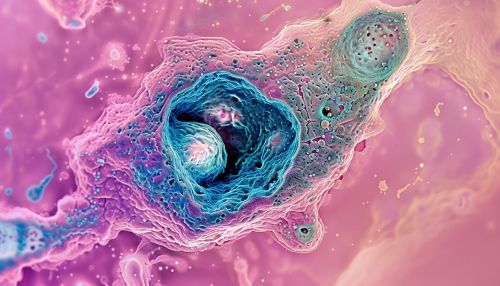Gastrinoma
Overview
A Gastrinoma is a rare type of tumor that typically originates in the pancreas or duodenum. These tumors secrete excess amounts of the hormone gastrin, leading to excessive stomach acid production and subsequent gastrointestinal ulcers.


Pathophysiology
Gastrinomas are part of a group of tumors known as neuroendocrine tumors (NETs). These tumors arise from the neuroendocrine cells, which are distributed throughout the body and have roles in both the endocrine (hormone-producing) and nervous systems. Gastrinomas specifically originate from the G cells located in the antrum of the stomach and the duodenum, which are responsible for producing and secreting the hormone gastrin.
Gastrin has a crucial role in the regulation of gastric acid secretion. It stimulates the parietal cells in the stomach to produce and secrete gastric acid. In a healthy individual, the secretion of gastrin is tightly regulated by a feedback mechanism. When the pH of the stomach becomes too acidic, gastrin secretion is inhibited. However, in the case of a gastrinoma, this feedback mechanism is disrupted. The tumor continuously secretes gastrin, leading to excessive gastric acid production, a condition known as hypergastrinemia.
The excessive gastric acid, in turn, leads to multiple and recurrent peptic ulcers in the stomach and duodenum. These ulcers can cause symptoms such as abdominal pain and gastrointestinal bleeding. If left untreated, these ulcers can lead to complications such as perforation and peritonitis, which can be life-threatening.
Clinical Presentation
Patients with gastrinomas typically present with symptoms related to peptic ulcer disease and hypergastrinemia. The most common symptom is abdominal pain, which is often described as burning or gnawing and is usually located in the upper abdomen. Other symptoms can include nausea, vomiting, loss of appetite, and weight loss.
In severe cases, patients may present with symptoms of gastrointestinal bleeding, such as black, tarry stools (melena), or vomiting blood (hematemesis). In rare cases, severe hypergastrinemia can lead to diarrhea due to increased gastric acid secretion and subsequent malabsorption.
Diagnosis
The diagnosis of a gastrinoma is often challenging due to the nonspecific nature of the symptoms and the rarity of the condition. The diagnosis is typically suspected in patients with multiple and recurrent peptic ulcers, especially if they are resistant to standard treatments.
The initial diagnostic test is a fasting serum gastrin level. Patients with gastrinomas typically have significantly elevated gastrin levels. However, a high gastrin level is not diagnostic of a gastrinoma, as other conditions can also cause elevated gastrin levels. Therefore, a positive test must be confirmed with a gastric acid secretion test, which measures the amount of gastric acid produced by the stomach.
Imaging studies, such as computed tomography (CT) or magnetic resonance imaging (MRI), are used to locate the tumor. In some cases, endoscopic ultrasound (EUS) may be used to identify small tumors that are not visible on CT or MRI.
Treatment
The primary treatment for gastrinomas is surgical removal of the tumor. However, due to the often advanced stage of the disease at diagnosis, complete surgical resection is not always possible. In these cases, debulking surgery may be performed to remove as much of the tumor as possible, which can help to alleviate symptoms and improve quality of life.
Medications are also used to manage the symptoms of gastrinomas. Proton pump inhibitors (PPIs) are the mainstay of treatment and are used to reduce gastric acid production. In some cases, somatostatin analogues may be used to inhibit gastrin secretion.
Prognosis
The prognosis of gastrinomas largely depends on the stage of the disease at diagnosis and the success of the surgical resection. Patients with localized disease who undergo complete surgical resection have a good prognosis, with a 5-year survival rate of over 90%. However, for patients with metastatic disease, the prognosis is significantly worse, with a 5-year survival rate of less than 50%.
Epidemiology
Gastrinomas are extremely rare, with an estimated incidence of 1-3 cases per million people per year. They can occur at any age but are most commonly diagnosed in adults between the ages of 30 and 50. There is no clear gender predilection.
